Enhanced Crystallinity and Luminescence Characteristics of Hexagonal Boron Nitride Doped with Cerium Ions According to Tempering Temperatures
Abstract
1. Introduction
2. Materials and Methods
2.1. Synthesis of Hexagonal Boron Nitride Nanophosphor Doped with Ce3+
2.2. Characterization of h-BN Nanophosphors
2.3. Applied Anti-Counterfeiting and Fingerprinting
3. Results and Discussion
3.1. Crystallinity and Morphology of Ce3+-Doped h-BN Nanophosphors
3.2. Luminescence of Ce3+-Doped h-BN Nanophosphors
3.3. Anti-Counterfeiting Application of Ce3+-Doped h-BN Nanophosphors
4. Conclusions
Author Contributions
Funding
Institutional Review Board Statement
Informed Consent Statement
Data Availability Statement
Acknowledgments
Conflicts of Interest
References
- Jiang, H.X.; Lin, J.Y. Review-Hexagonal Boron Nitride Epilayers: Growth, Optical Properties and Device Applications. ECS J. Solid State Sci. Technol. 2016, 6, 3012–3021. [Google Scholar] [CrossRef]
- Favennec, P.N.; L’Haridon, H.; Salvi, M.; Moutonnet, D.; Le Guillou, Y. Luminescence of erbium implanted in various semiconductors: IV, III-V and II-VI materials. Electron. Lett. 1989, 25, 718–719. [Google Scholar] [CrossRef]
- Dean, C.R.; Young, A.F.; Meric, I.; Lee, C.; Wang, L.; Sorgenfrei, S.; Watanabe, K.; Taniguchi, T.; Kim, P.; Shepard, K.L.; et al. Boron nitride substrates for high-quality graphene electronics. Nat. Nanotechnol. 2010, 5, 722–726. [Google Scholar] [CrossRef] [PubMed]
- Huang, B.; Cao, X.K.; Jiang, H.X.; Lin, J.Y.; Wei, S. Origin of the significantly enhanced optical transitions in layered boron nitride. Phys. Rev. B Condens. Matter Mater. Phys. 2012, 86, 155202. [Google Scholar] [CrossRef]
- Song, L.; Ci, L.; Lu, H.; Sorokin, P.B.; Jin, C.; Ni, J.; Kvashnin, A.G.; Kvashnin, D.G.; Lou, J.; Yakobson, B.I.; et al. Large Scale Growth and Characterization of Atomic Hexagonal Boron Nitride Layers. Nano. Lett. 2010, 10, 3209–3215. [Google Scholar] [CrossRef]
- Sugino, T.; Tanioka, K.; Kawasaki, S.; Shirafuji, J. Characterization and Field Emission of Sulfur-Doped Boron Nitride Synthesized by Plasma-Assisted Chemical Vapor Deposition. Jpn. J. Appl. Phys. 1997, 36, 463–466. [Google Scholar] [CrossRef]
- Kubota, Y.; Watanabe, K.; Tsuda, O.; Taniguchi, T. Deep Ultraviolet Light-Emitting Hexagonal Boron Nitride Synthesized at Atmospheric Pressure. Science (Am. Assoc. Adv. Sci.) 2007, 317, 932–934. [Google Scholar] [CrossRef]
- Oder, T.N.; Kim, K.H.; Lin, J.Y.; Jiang, H.X. III-nitride blue and ultraviolet photonic crystal light emitting diodes. Appl. Phys. Lett. 2004, 84, 466–468. [Google Scholar] [CrossRef]
- Silly, M.G.; Jaffrennou, P.; Barjon, J.; Lauret, J.-S.; Ducastelle, F.; Loiseau, A.; Obraztsova, E.; Attal-Tretout, B.; Rosencher, E. Luminescence properties of hexagonal boron nitride: Cathodoluminescence and photoluminescence spectroscopy measurements. Phys. Rev. B Condens. Matter Mater. Phys. 2007, 75, 085205. [Google Scholar] [CrossRef]
- Majety, S.; Cao, X.K.; Li, J.; Dahal, R.; Lin, J.Y.; Jiang, H.X. Band-edge transitions in hexagonal boron nitride epilayers. Appl. Phys. Lett. 2012, 101, 51110. [Google Scholar] [CrossRef]
- Watanabe, K.; Taniguchi, T.; Kanda, H. Direct-bandgap properties and evidence for ultraviolet lasing of hexagonal boron nitride single crystal. Nat. Mater. 2004, 3, 404–409. [Google Scholar] [CrossRef] [PubMed]
- Museur, L.; Kanaev, A. Near band-gap photoluminescence properties of hexagonal boron nitride. J. Appl. Phys. 2008, 103, 103520. [Google Scholar] [CrossRef]
- Ahmad, P.; Khandaker, M.U.; Amin, Y.M.; Muhammad, N.; Khan, G.; Khan, A.S.; Numan, A.; Rehman, M.A.; Ahmed, S.M.; Khan, A. Synthesis of hexagonal boron nitride fibers within two hour annealing at 500 °C and two hour growth duration at 1000 °C. Ceram. Int. 2016, 42, 14661–14666. [Google Scholar] [CrossRef]
- Wu, J.; Yi, L.; Zhang, L. Tuning the electronic structure, bandgap energy and photoluminescence properties of hexagonal boron nitride nanosheets via a controllable Ce3+ ions doping. RSC Adv. 2013, 3, 7408. [Google Scholar] [CrossRef]
- Steckl, A.J.; Garter, M.; Birkhahn, R.; Scofield, J. Green electroluminescence from Er-doped GaN Schottky barrier diodes. Appl. Phys. Lett. 1998, 73, 2450–2452. [Google Scholar] [CrossRef]
- Jadwisienczak, W.M.; Lozykowski, H.J.; Perjeru, F.; Chen, H.; Kordesch, M.; Brown, I.G. Luminescence of Tb ions implanted into amorphous AlN thin films grown by sputtering. Appl. Phys. Lett. 2000, 76, 3376–3378. [Google Scholar] [CrossRef]
- Jung, J.; Baek, Y.; Lee, J.; Kim, Y.; Cho, S.; Kim, Y. The structure and luminescence of boron nitride doped with Ce ions. Appl. Phys. A 2018, 124, 1–6. [Google Scholar] [CrossRef]
- Pereira, M.F. Analytical Expressions for Numerical Characterization of Semiconductors per Comparison with Luminescence. Materials 2018, 11, 2. [Google Scholar] [CrossRef]
- Alkoy, S.; Toy, C.; Gönül, T.; Tekin, A. Crystallization behavior and characterization of turbostratic boron nitride. J. Eur. Ceram. Soc. 1997, 17, 1415–1422. [Google Scholar] [CrossRef]
- Sarkar, S.; Gan, Z.; An, L.; Zhai, L. Structural Evolution of Polymer-Derived Amorphous SiBCN Ceramics at High Temperature. J. Phys. Chem. C 2011, 115, 24993–25000. [Google Scholar] [CrossRef]
- Gorbachev, R.V.; Riaz, I.; Nair, R.R.; Jalil, R.; Britnell, L.; Belle, B.D.; Hill, E.W.; Novoselov, K.S.; Watanabe, K.; Taniguchi, T.; et al. Hunting for Monolayer Boron Nitride: Optical and Raman Signatures. Small (Weinh. Bergstr. Ger.) 2011, 7, 465–468. [Google Scholar] [CrossRef] [PubMed]
- Wu, J.; Han, W.; Walukiewicz, W.; Ager, J.W.; Shan, W.; Haller, E.E.; Zettl, A. Raman Spectroscopy and Time-Resolved Photoluminescence of BN and BxCyNz Nanotubes. Nano Lett. 2004, 4, 647–650. [Google Scholar] [CrossRef]
- Li, J.; Yuan, C.; Elias, C.; Wang, J.; Zhang, X.; Ye, G.; Huang, C.; Kuball, M.; Eda, G.; Redwing, J.M.; et al. Hexagonal Boron Nitride Single Crystal Growth from Solution with a Temperature Gradient. Chem. Mater. 2020, 32, 5066–5072. [Google Scholar] [CrossRef]
- Wu, Y.; Chen, Y.; Wang, D.; Lee, C.; Sun, C.; Chen, T. α-(Y,Gd)FS:Ce3+: A novel red-emitting fluorosulfide phosphor for solid-state lighting. J. Mater. Chem. 2011, 21, 15163. [Google Scholar] [CrossRef]
- Chowdhury, C.; Jahiruddin, S.; Datta, A. Psuedo Jahn-Teller Distortion in Two-Dimensional Phosphorus: Origin of Black and Blue Phases of Phosphorene and Band Gap Modulation by Molecular Charge Transfer. J. Phys. Chem. Lett. 2016, 7, 1288–1297. [Google Scholar] [CrossRef]
- Qin, X.; Liu, X.; Huang, W.; Bettinelli, M.; Liu, X. Lanthanide-Activated Phosphors Based on 4f-5d Optical Transitions: Theoretical and Experimental Aspects. Chem. Rev. 2017, 5, 4488–4527. [Google Scholar] [CrossRef]

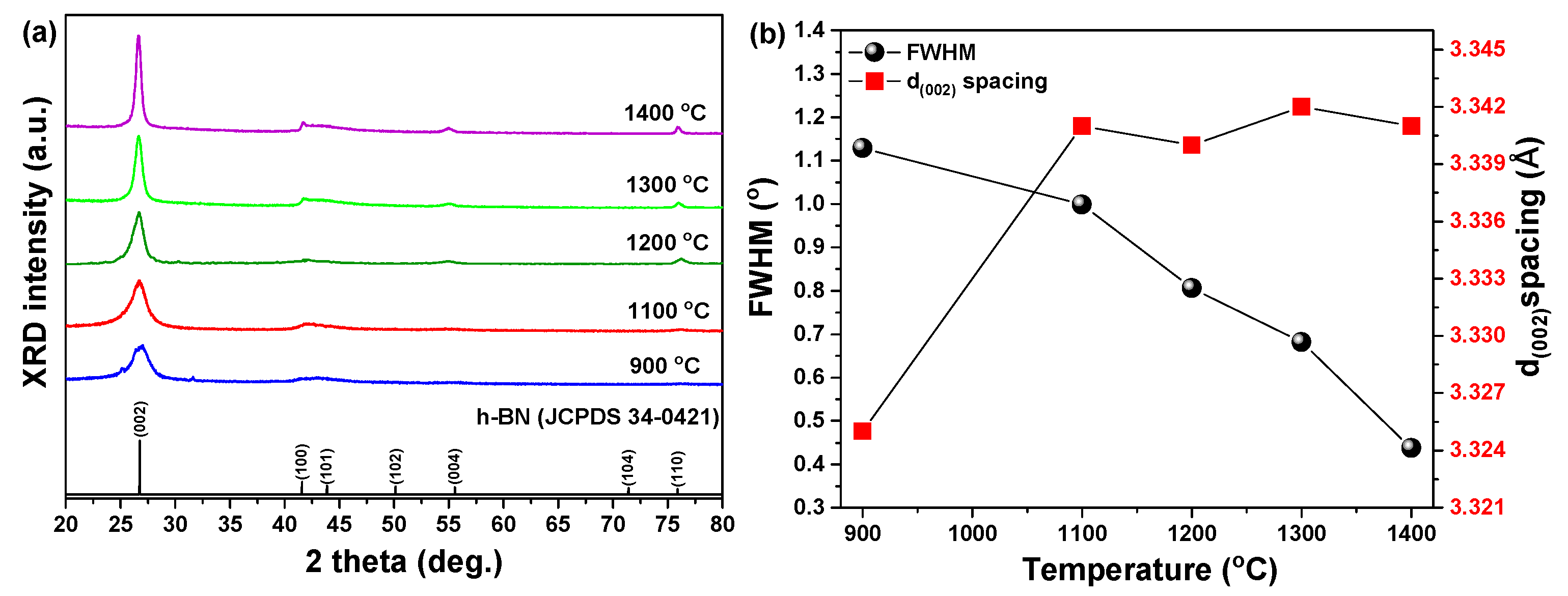
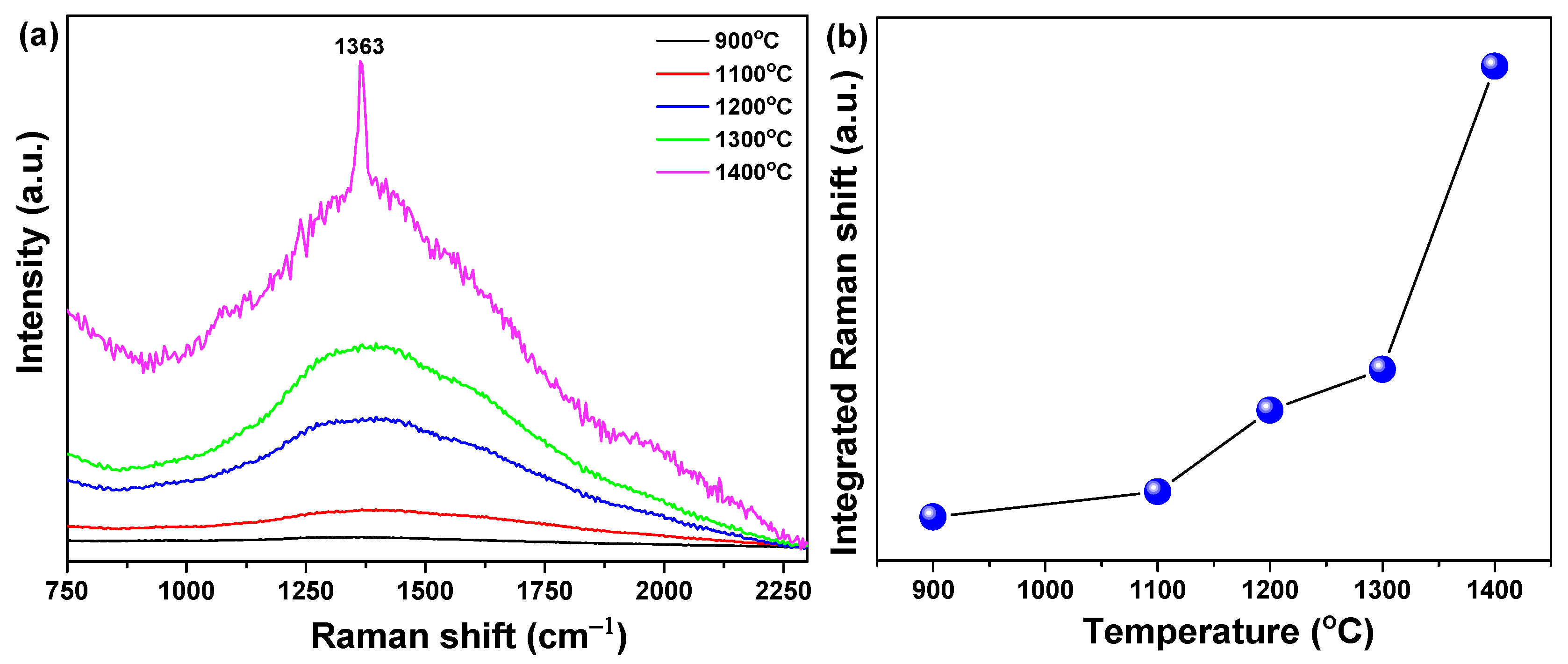
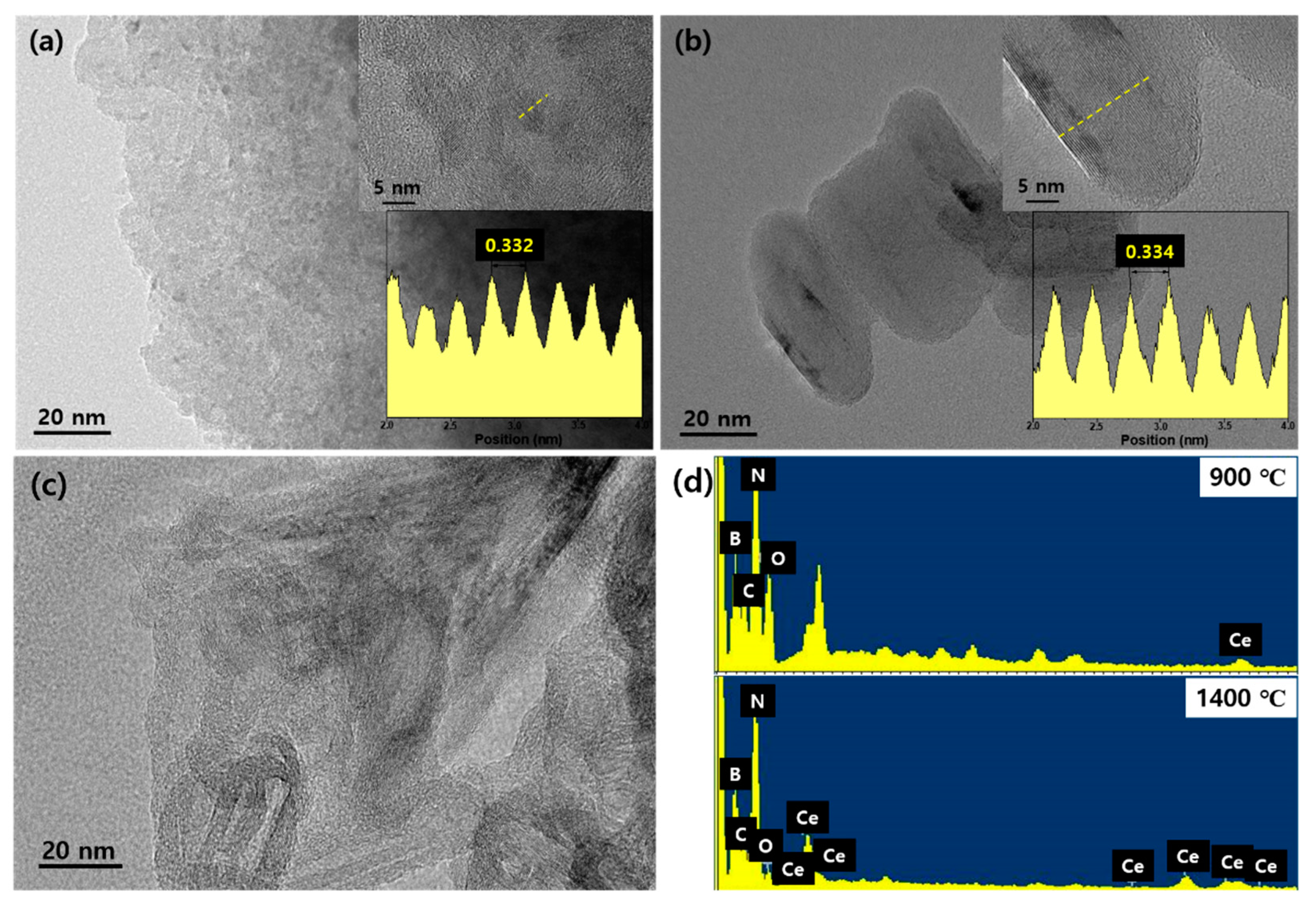
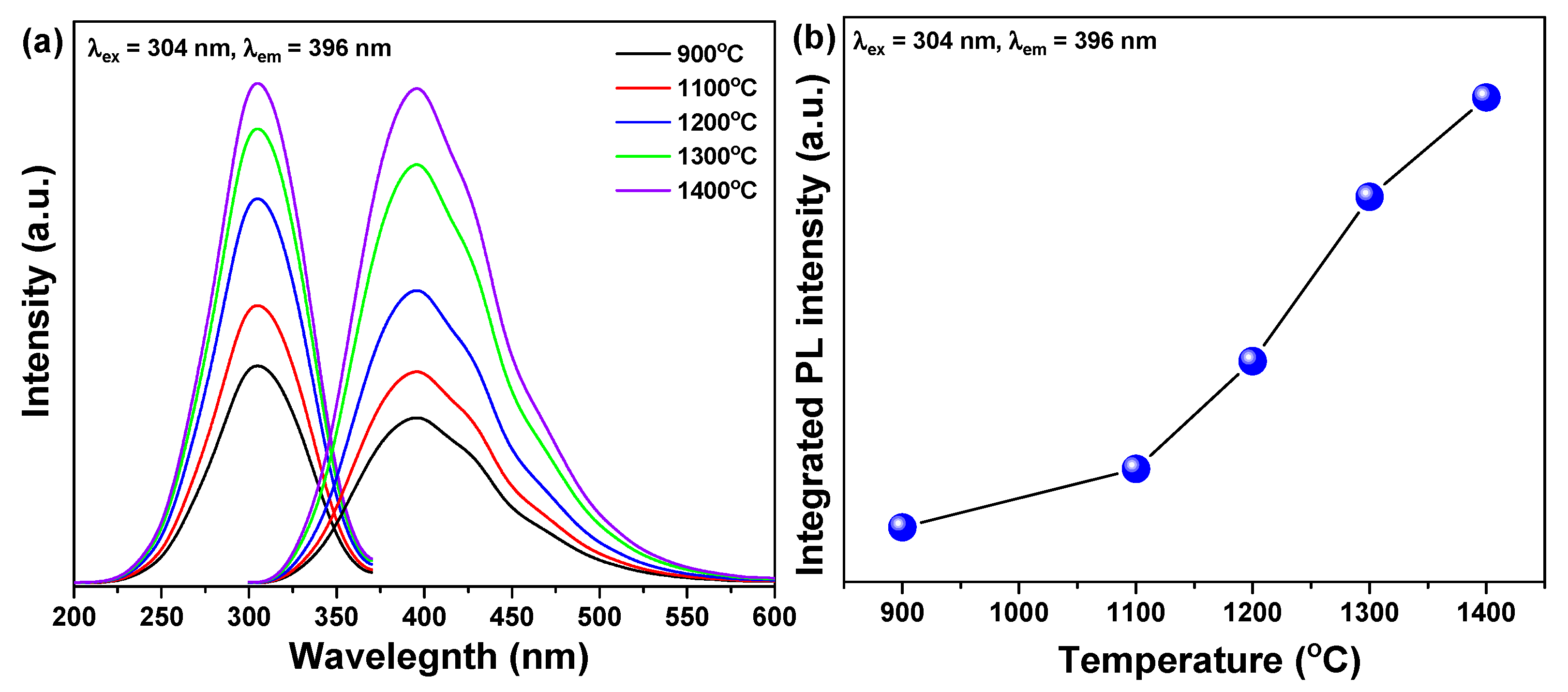
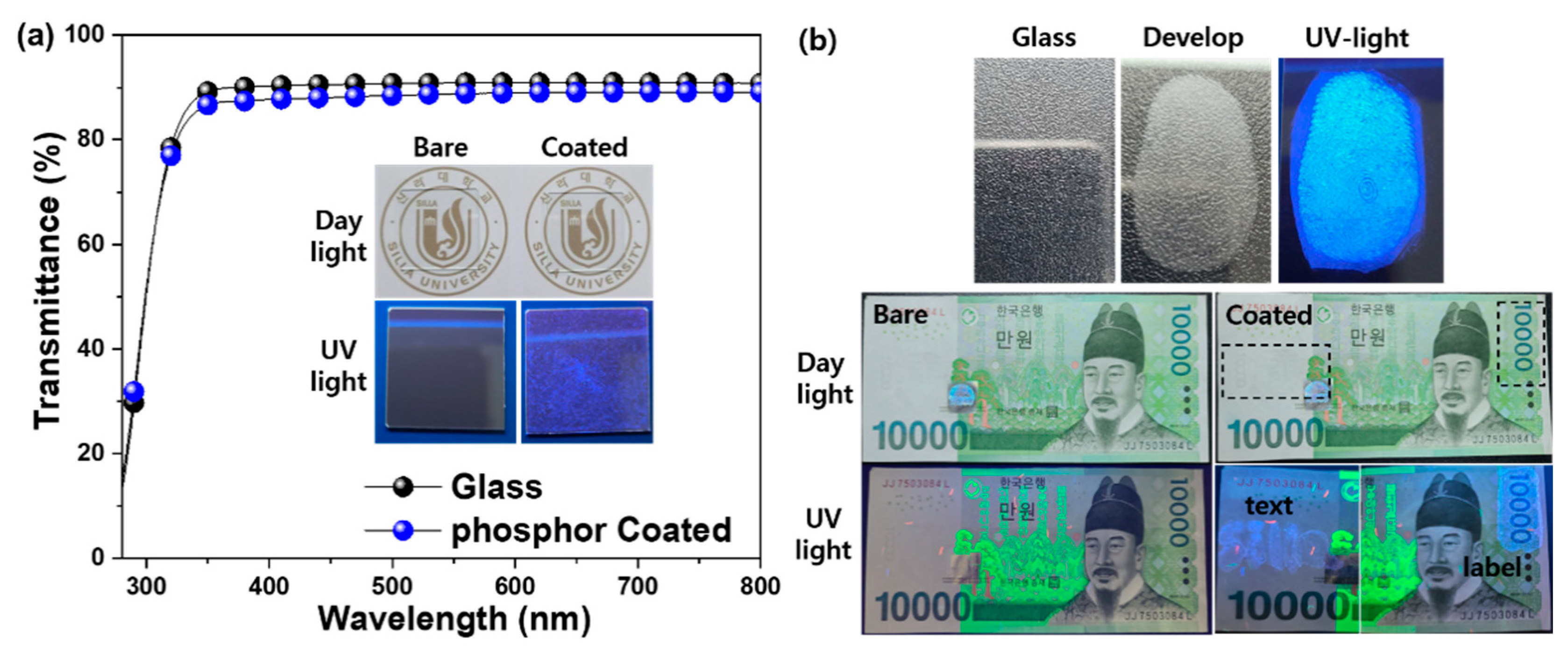
Publisher’s Note: MDPI stays neutral with regard to jurisdictional claims in published maps and institutional affiliations. |
© 2021 by the authors. Licensee MDPI, Basel, Switzerland. This article is an open access article distributed under the terms and conditions of the Creative Commons Attribution (CC BY) license (http://creativecommons.org/licenses/by/4.0/).
Share and Cite
Jung, J.Y.; Kim, J.; Kim, Y.D.; Kim, Y.-K.; Cha, H.-R.; Lee, J.-G.; Son, C.S.; Hwang, D. Enhanced Crystallinity and Luminescence Characteristics of Hexagonal Boron Nitride Doped with Cerium Ions According to Tempering Temperatures. Materials 2021, 14, 193. https://doi.org/10.3390/ma14010193
Jung JY, Kim J, Kim YD, Kim Y-K, Cha H-R, Lee J-G, Son CS, Hwang D. Enhanced Crystallinity and Luminescence Characteristics of Hexagonal Boron Nitride Doped with Cerium Ions According to Tempering Temperatures. Materials. 2021; 14(1):193. https://doi.org/10.3390/ma14010193
Chicago/Turabian StyleJung, Jae Yong, Juna Kim, Yang Do Kim, Young-Kuk Kim, Hee-Ryoung Cha, Jung-Goo Lee, Chang Sik Son, and Donghyun Hwang. 2021. "Enhanced Crystallinity and Luminescence Characteristics of Hexagonal Boron Nitride Doped with Cerium Ions According to Tempering Temperatures" Materials 14, no. 1: 193. https://doi.org/10.3390/ma14010193
APA StyleJung, J. Y., Kim, J., Kim, Y. D., Kim, Y.-K., Cha, H.-R., Lee, J.-G., Son, C. S., & Hwang, D. (2021). Enhanced Crystallinity and Luminescence Characteristics of Hexagonal Boron Nitride Doped with Cerium Ions According to Tempering Temperatures. Materials, 14(1), 193. https://doi.org/10.3390/ma14010193




